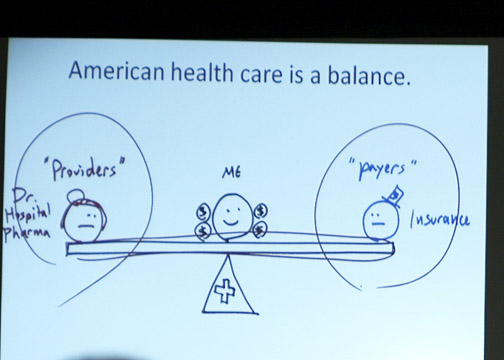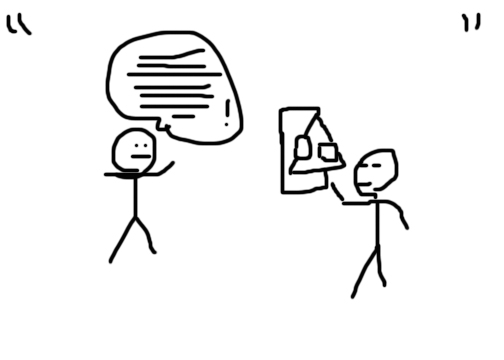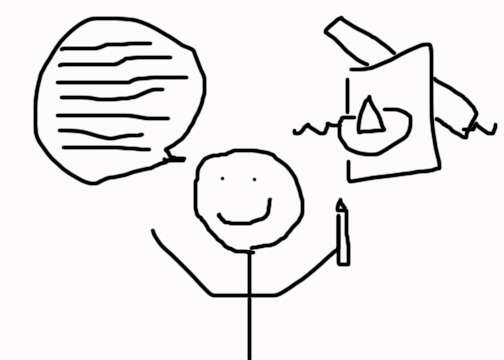How does one go about writing on a panel entitled “Blah Blah Blah: Why Words Don’t Work”? Well, to apply recently learned knowledge, let me draw a picture of my problem:

Dan Roam, of Back of the Napkin fame, discussed how verbal thinking has limited our problem solving skills for the past couple of centuries.
“We’ve come to equate our intelligence with our ability to speak” said Roam. If a person can speak, and speak well, we assume they are intelligent and vice versa. Thus, according to Roam, education systems and social acceptance has been based largely on a measure of intelligence which is, in turn, based on verbal communication skills. All the while, visual communication skills go unnoticed and are subsequently left out of assessment exams such as the SAT, ACT, etc. and kept away from the public and political discourse.
The downfall here, is that not everyone is a verbal thinker.
Roam quotes Einstein: “I rarely think in words at all. My visual images have to be translated laboriously into conventional verbal and mathematical terms”
Not only are many people visual thinkers, but major limitations in strict verbal communication lie in the complexity of many of the topics discussed and debated in our society today, claims Roam. Roam used an example within politics as he explained, through a combination of visuals and verbal communication, the health care dilemma that our country currently faces. Roam questions how many people can truly understand a 1400 page document as complex as our health bill? Roam is baffled that our congress is expected to read the entire document and understand it fully, and that all of our political sessions are conducted in these verbal layouts.

Roam, with Dr. Tony Jones created “American Health Care: A 4-Napkin Explanation”, and visually explained the health care dilemma. This slide show was so effective that Fox News gave him a prime-time slot to present it to the United States.
According to Roam, within a week of posting this “educational, non-entertainment” topic, the site had 200,000 hits. This means people were voluntarily clicking on a link that would lead them to learn about and understand the health care system. Wow!
The health care system explanation was just one example of how effective the combination of verbal and visual communication can be when it comes to solving problems or explaining ideas.
Here is a visual/verbal summary of Roam’s conclusion:
Roam is realistic and understands that most people are not either strictly visual or verbal. Having limited appraisal of intelligence and keeping discourse in the verbal realm is just as bad as moving everything fully into the visual world.


However, if we can combine verbal and visual skills, we can be confident that the chances of understanding, explaining, and solving problems will be much more effective and thorough.
Now, if I can only convince my professors at Texas State that sketches and illustrations can be substituted for 10-page research papers, I will be set!

Permalink
The thought of combining verbal and visual skills is inspiring. I am constantly confronted with peers saying, “I know what I mean, I just can’t put it into words.”
Since we have been leaning toward verbal skills for so long, I am fairly certain school systems will be reluctant to change to a verbal/visual stance.
Permalink
I love the idea behind Romes statement. Not to knock politicians but I can guarantee almost a third don’t fully understand the health care reform. I too find myself from time to time as more of a visual thinker when it comes to mathematics or science, So I can definitely connect with his model.
My worries are that in today’s society where education is everything is it really socially acceptable to be more of a visual thinker? Also does it really work for everything? I mean look at the war in Iraq. This has been going on for so long now and so many facts and concerns and facts are out there its almost impossible to make heads or tails of the entire situation. So I ask is it possible to sum up such a situation like the war in Iraq through a visual means of communication opposed through literal and statistical?
Permalink
How would you test a visual thinker on a standardized test like the SAT or ACT? A drawing seems to me to be completely subjective. What looks like a cat to one grader could look like a shoe to another, especially if the student being graded doesn’t have much artistic talent (like me).
In my experience, teachers use a mix of visual, verbal, and tactile teaching methods in the classroom, which usually is enough to accommodate all kinds of learners/thinkers.
Permalink
A little black and white smiley on a teeter totter sums up 2700 page reports, brilliant. I find myself wanting to go of on a tangent about how comic books and the graphic novel have evolved to shape a generations perception, but I refrain..
To the previous user’s comment about wether or not a more visual approach to educating the public about Iraq would work… I am a veteran who has been to Iraq twice and I think it depends on what you mean would it” work”.
If by “work” you mean, could America continue to perpetuate a pointless war if there were more images coming from the region. NO. The “literal and statistical” information is a part of the problem with any war. Success in Vietnam was measure by kill count. People, living or dead, are not numbers and and the cost of war can never be wholly expressed in a literal or statistical manner.
If by “work” you mean, could the war be over if there were more visual communication coming from Iraq without passing via the mil-PAO. Hell yeah. Anyone can ignore a number scrolling the ticker, but if you can ignore a picture of a kid who lost his parents and his legs to an American bomb your not human.
Permalink
The very first thing that I think of after reading Roam’s theory is politicians. As voters, we get caught up in the idea that a good public speaker will be a good leader. I know that I am guilty of it. During the last presidential election, I was completely charmed by Obama’s eloquent language and relaxed attitude, and McCain’s voice isn’t as smooth and he bumbled through his words often.
I agree that visual and verbal intelligence must go hand in hand, but before we can get to that point, we need to be able to recognize intelligence over good verbal skills. Maybe Roam could draw me a napkin diagram that explains how to tell when someone actually knows what they are talking about.
Permalink
I am more a verbal thinker, and after I learn more about the maternal, I begin to visualize it. When I was younger I used watch cartoons and read graphic novels so I was visual thinker. As I got older and began to read more, I became more a verbal thinker. Pictures are lot easier to mentally absorb and the images remain longer in the mind. It easier to understand what is going on and to understand emotion from pictures, may it be movies, news, TV or art work.
With words, it may be harder for some to grasp what is going on from just words, especially if they do not understand or know the definition of a word and have to look it up. That is why news is mostly image based with voiceovers and reporter packages so the viewer can understand what is happening. For radio and print, the message is verbal so the important information is at the top and the less important details are at the bottom. As a Electronic Media major, it is important for to understand the power or words and pictures and how the audience will interpret them.
Permalink
I thoroughly enjoyed this article because my whole life I’ve been much better at creating an idea rather than saying or putting into words. I love the illustrations and the fact that I am not alone in my fight against 10 page essays.
I love to read though and I can understand verbal ways of learning, my issue is more about me putting my ideas into words.
Permalink
When I first starting reading this post, I thought: give me a break. Of course strong verbal communication skills are the ticket to effective communication. However, Roam puts a new spin on the idea for me. I’m a communication studies major, and I think much of the time people keep caught up in the audible and forget effective communication varies person to person.
I’ll look forward to checking out their site.
Permalink
I also an a visual thinker. I tend to speak and understand things and match them with a picture that is in my head. Its amazing because some peole might not understand why and how you can put a picture with everything that a person says, but what you dont realize is that MANY people are Visual thinkers…some just dont know how to draw it out on paper…
Permalink
I am one of “those” people that is often at a loss for words not because of the shock of a situation, but because I can’t translate the image in my head into actual words. This makes me wonder what people think about my intelligence while I’m standing there, stumbling around for the right words to say. I am a very visual person, especially when it comes to classroom learning. As a political science minor, I’ve sat in a daze through a countless number of lectures because they didn’t have any visual references. No slides or writing on the chalkboard, it was all talk and no visual. I can’t tell you much about what the professors, bless their hearts, talked about during their lectures because it was impossible for me to pay attention because there wasn’t anything that was visually appealing.
How can we encourage more professors to incorporate visuals into their lectures? How do we break the stigma that people without verbal skills aren’t intelligent and that people with good verbal skills are?
Permalink
I believe that combining verbal and visual skills to help others learn is great. Not everyone relates to verbal intellect and can use pictures to grasp a better understanding.
For me, during my many years of school it has come in handy to use both the skills to help me comprehend the lesson at hand. I think this is a great idea.
If we could only get professors on board with this idea I think everyone would be happy!